|
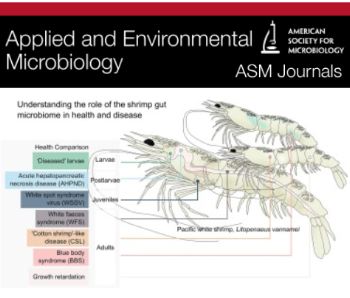
One of the most predominant animal species in global aquaculture is the whiteleg shrimp (Penaeus vannamei)
Boosting Whiteleg Shrimp Productivity: The Microbiome Advantage
 UNITED STATES
UNITED STATES
Thursday, April 17, 2025, 01:00 (GMT + 9)
Microbiome analysis emerges as a powerful predictor of survival and growth in shrimp aquaculture
In a groundbreaking study published in Applied and Environmental Microbiology, researchers have unveiled a novel method for predicting the productivity of whiteleg shrimp (Penaeus vannamei) farming—by analyzing the microbiome of the shrimp and their environment. The study represents a major leap forward in aquaculture science, revealing how microbial communities can be harnessed to improve survival rates and growth performance in one of the world's most valuable seafood commodities.
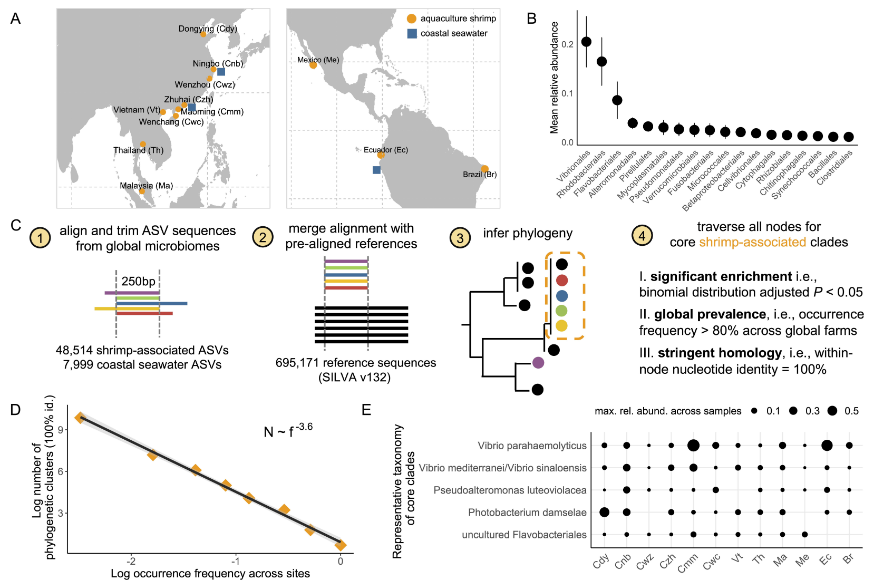
Identifying core clades of shrimp-associated microbiome from global aquaculture. (A) Geographic distribution of microbiome data sets compiled in this study. The orange circle indicates a shrimp-associated microbiome. Blue square indicates coastal seawater microbiome. (B) Ranked mean relative abundance of bacterial taxa across global shrimp-associated microbiomes. (C) A bioinformatic pipeline is developed to identify core clades of shrimp-associated microbiome. See Materials and Methods for full descriptions. (D) A power law relationship between the number of phylogenetic clusters N and the occurrence frequency of phylogenetic clusters f. (E) Representative taxonomy of the identified core clades of global shrimp-associated microbiome. The size of the dots indicates the maximal relative abundance of a clade in a microbiome. Acronyms of locations are provided in panel A. Cdy, China Dongying; Cnb, China Ningbo; Cwz, China Wenzhou; Czh, China Zhuhai; Cmm, China Maoming; Cwc, China Wenchang; Vt, Vietnam; Th, Thailand; Ma, Malaysia; Me, Mexico; Ec, Ecuador; Br, Brazil. .Click on the image to enlarge it
Microbiomes Predict Performance
The research team conducted a large-scale analysis of microbiome data from shrimp farms across Asia and Latin America, integrating 579 shrimp-related and 154 seawater samples. Their findings revealed that microbial composition can predict key indicators of productivity:
-
In the larval stage, the microbiome serves as a strong predictor of shrimp survival.
-
In the adult stage, water quality becomes more influential, showing a stronger correlation with growth and weight.
This shift in key environmental drivers through the shrimp’s life cycle provides actionable insight for farm management.
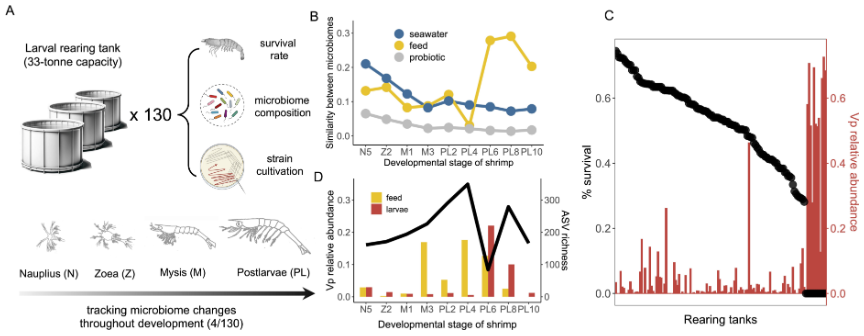
Microbiome characterization in a shrimp hatchery. (A) Shrimp larvae were sampled from 130 33-ton capacity tanks where the survival rate of shrimp larvae was counted and recorded. The sampled shrimp larvae were further used for microbiome sequencing and bacterial strain isolation. For four selected tanks, we sampled throughout the developmental stages from nauplius, zoea, and mysis to postlarvae. The potential sources of microbiome such as seawater, feed (microalgae at the nauplius and zoea stage and Artemia at the mysis and postlarvae stage) as well as probiotics were also sampled and sequenced. (B) The similarity between shrimp larvae-associated microbiome composition and microbiome composition of potential sources. Similarity is calculated as 1- Bray-Curtis dissimilarity based on relative abundance. (C) Black dots show the ranked survival rate of shrimp larvae across 130 tanks. The red bar shows a relative abundance of V. parahaemolyticus in the corresponding shrimp larvae-associated microbiome. (D) The black line indicates the richness of shrimp larvae-associated microbiome across developmental stages. The red bar and yellow bar indicate relative abundances of V. parahaemolyticus across developmental stages in shrimp larvae microbiome and microbiome in the feed. Icons of shrimp and petri dish were created by BioRender. .Click on the image to enlarge it
A Global View of Shrimp Microbiomes
By constructing a database of over 56,000 amplicon sequence variants (ASVs), researchers identified significant differences between farm-associated microbiomes and natural coastal waters. The aquaculture environment appears to select for certain microbial taxa. While nutrient-poor oceanic bacteria like SAR11 were rare in shrimp environments, nutrient-rich groups such as Vibrionales, Rhodobacterales, and Flavobacteriales dominated.
Importantly, the shrimp microbiome includes both harmful and potentially beneficial organisms. For example:
-
Pathogens: Vibrio parahaemolyticus, the causative agent of **acute hepatopancreatic necrosis disease (AHPND)*, continues to threaten shrimp farms worldwide.
-
Beneficial microbes: Pseudoalteromonas luteoviolacea, part of the Alteromonadales, can produce antimicrobial compounds that inhibit pathogens.

Microbiome composition as a strong predictor of shrimp larvae survival. (A) Statistical learning of microbiome composition to predict survival rate of shrimp larvae. Prediction power is indicated by leave-one-out cross-validation R2. (B) The observed survival rate of shrimp larvae and that predicted by microbiome composition through leave-one-out cross-validation. The 13 tanks where a bloom of V. parahaemolyticus led to the collapse of all shrimp larvae were excluded. (C) The prediction power of microbiome composition linearly increases as the number of samples increases. On average, increasing every 10 samples leads to a 2.5% increase in prediction power. (D) Taxa show the highest feature importance in statistical learning to predict the survival rate of shrimp larvae. Purple lines indicate potential primary degraders. Yellow lines indicate potential scavengers. .Click on the image to enlarge it
Hatchery Survival and Microbial Predictors
Focusing on shrimp hatcheries in Ecuador, researchers found that the early-stage microbiome is crucial for survival. Larvae start with a microbial community resembling seawater, but this shifts toward feed-associated microbes (like Artemia) as they develop. Probiotics, however, were found to colonize poorly.
In a detailed study of 130 culture ponds, researchers identified microbiome profiles that predicted nearly 50% of survival rate variation—even after excluding ponds wiped out by Vibrio outbreaks. Key predictors were polysaccharide-degrading microbes, which help process nutrients and possibly outcompete pathogens.
Further genetic analysis revealed that certain microbial strains had acquired genes to:
-
Produce vitamins and growth factors (e.g., vitamin B6, lysine)
-
Degrade proteins and transport nutrients, enhancing shrimp nutrition
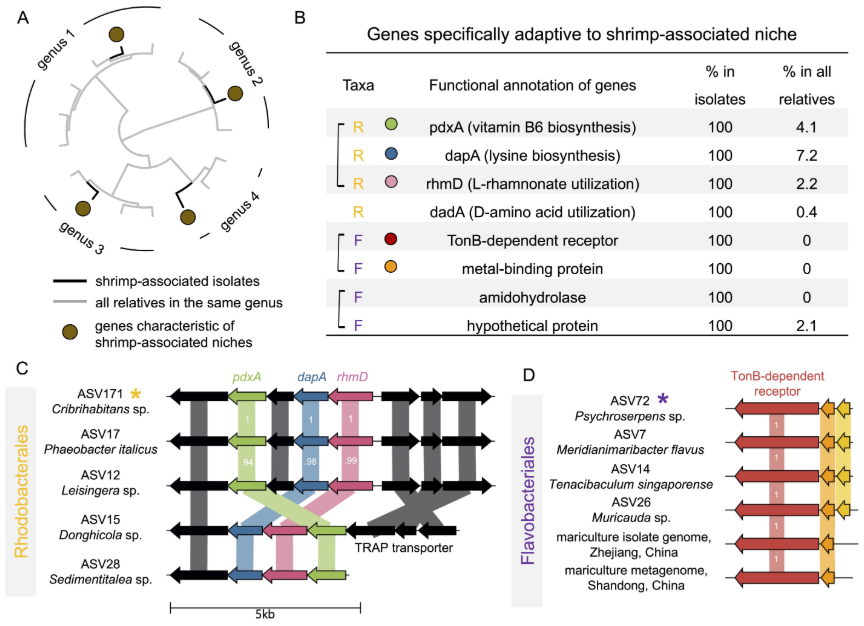
Horizontal transfer of genes that are specifically adaptive to a shrimp-associated niche. (A) Schematic illustration of comparative genomic analysis for identifying genes that are specifically adaptive to a shrimp-associated niche. The selected genes are shared by isolates that are abundant in the shrimp larvae microbiome but are present in none or very few (<10%) of all the other publicly available genomes in the same taxonomic clades. Tips colored in black indicate strains isolated from the shrimp larvae samples. Tips colored in gray indicate publicly available genomes in the same genus as the shrimp-associated isolates. The brown circle indicates a gene that is only present in the genome of shrimp-associated isolates but not in any other genomes from the same genus. (B) A total of 8 genes are identified from the shrimp larvae-associated microbiome. Genes marked with a yellow “R” are shared by all five abundant isolates in the Rhodobacterales clade. Genes marked with a purple “F” are shared by all four abundant isolates in the Flavobacteriales clade. All these genes are rarely present in other genomes of the same genera from public databases (<10%). The 16S rRNA sequences of all nine isolates are 100% identical to ASVs in the sequenced shrimp larvae microbiome whose maximal relative abundances across tanks are at least 1%. Square brackets indicate that genes are next to each other in the genome. (C) Gene map of adjacent genes (pdxA, dapA, and rhmD) experiencing horizontal transfer across five isolates from distinct genera in the order of Rhodobacterales. Numbers in the gene map indicate the level of amino acid sequence identity between homologs. (D) Gene map of two adjacent genes (TBDR and a metal-binding protein gene) experiencing recent horizontal transfer among four isolates from distinct genera in the order of Flavobacteriales isolated from shrimp larval hatchery in Ecuador, as well as their homologs in publicly available genome and metagenome derived from aquaculture in different regions of China. All the six TBDR genes have 100% identical sequences with each other. .Click on the image to enlarge it
Adult Growth Tied to Water Quality
In the adult stage, samples from six Ecuadorian farms showed that the microbiomes of shrimp intestines and hepatopancreas offered limited predictive value for growth (R² = 0.16–0.18). However, water quality parameters such as:
-
Alkalinity
-
Nitrogen levels
-
Cyanobacteria density
-
Redox potential
...had a strong predictive power (R² = 0.63), suggesting that managing water chemistry is crucial for maximizing adult shrimp growth.
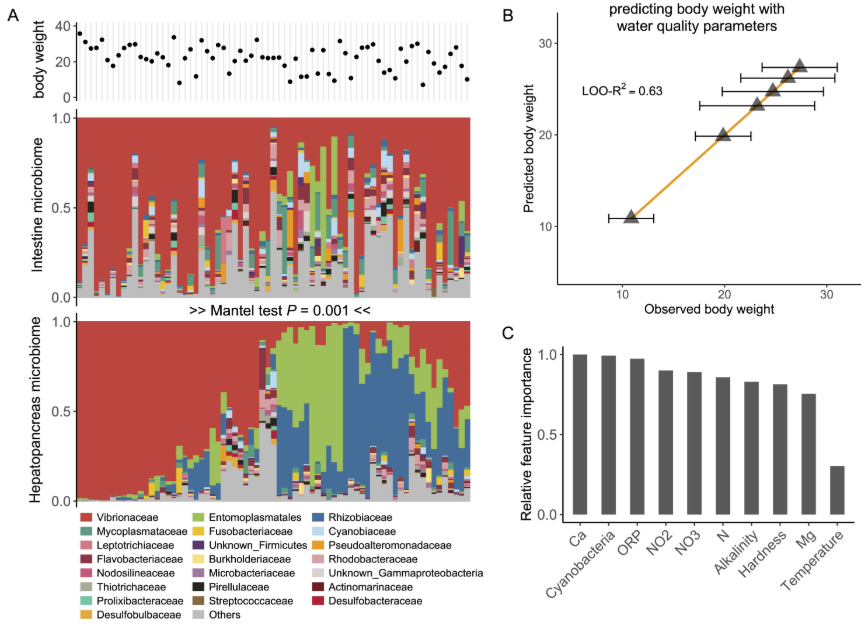
Adult shrimp body weight is better predicted by water quality than microbiome composition. (A) Adult shrimp individuals were sampled for body weight measurement and microbiome sequencing of hepatopancreas and the intestine. The microbiome composition in the intestine and that in the hepatopancreas are significantly correlated with each other. (B) The body weight of adult shrimp can be accurately predicted by water quality parameters. (C) Relative feature importance of water quality parameters in predicting adult shrimp body weight. ORP, oxidoreductive potential. Click on the image to enlarge it
The Future: Microbiome Engineering in Aquaculture
This study highlights the strategic importance of the microbiome as a tool for boosting aquaculture efficiency. While the microbiome is key in the early stages of shrimp development, water quality management becomes paramount later on.
Researchers propose future efforts to:
-
Create experimental models with precise environmental controls
-
Explore the genetic determinants of microbial impact on shrimp
-
Use microbiome engineering to selectively promote beneficial microbes and suppress harmful ones
With global whiteleg shrimp production already reaching 5.8 million tons in 2020, the findings offer a timely roadmap to improve yields, reduce disease risks, and support sustainable aquaculture.
Source: "A new approach to predicting productivity of Penaeus vannamei aquaculture based on microbiome analysis" – Applied and Environmental Microbiology
[email protected]
www.seafood.media
|



